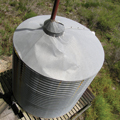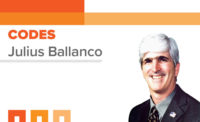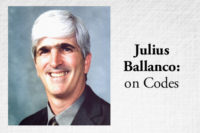Green Supplement champions sustainable practices.

Within the past few months, both ICC and IAPMO completed work on their respective green codes. Having sat through both hearings, I have to say IAPMO knows green. When it comes to plumbing issues, it is leaps and bounds above anyone else regarding green issues.
Green code requirements can be very nebulous. What is green? How far do code requirements have to go to be considered green? These are the very issues that are part of the discussion on green code requirements.
IAPMO developed a Green Plumbing and Mechanical Code Supplement. The reason the document is a supplement is because there are already green code requirements in the Uniform Plumbing Code and the Uniform Mechanical Code. The green code requirements go beyond the basic code requirements. While I first questioned titling the document this way, it does make perfect sense. It would be insulting of any code to assume that a base code does not have green code requirements.
The reason IAPMO is far ahead of anyone else is due to its alternate water source requirements. Some call this water graywater; others call it reclaimed water. IAPMO clearly establishes what each type of water is. Depending on how you read the requirements, there are either four or five categories of alternate water sources.
The four main categories are: reclaimed (recycled) water, rainwater, graywater and onsite treated nonpotable water. The fifth category would be potable rainwater. The source is the same - rainwater - however, the rainwater is treated to be used as drinking water. All the other alternate sources are nonpotable water.
Alternate water source
The alternate water source requirements are very thorough, as well as understandable. Anyone involved in an alternate water source project is well-advised to utilize the IAPMO Green Supplement.
One of the important aspects of the alternate water source is the treatment, testing and verification requirements of the water. Any alternate water source must be properly treated so that it is safe to use in a building. To assure that the water is safe, there needs to be periodic testing. The testing verifies the quality of the water as being safe.
A table in Chapter 5 of the Green Supplement lists the minimum frequency of testing required for the alternate water source. The table also identifies inspection and maintenance requirements. All too often, building owners assume that once a green system is installed, they are done with it. Of course, every engineer recognizes that an alternate water source requires continuous maintenance, as well as inspection. This will assure that the water source is safe for the building occupants to use.
One of the more controversial alternate water sources is onsite treated nonpotable water. Basically, any water source is permitted to be treated and used for the flushing of water closets and urinals. The common approach has been the use of graywater for this application. However, the requirements do not restrict the water source to graywater. Any waste water, groundwater, rainwater, etc. can be used.
Final hearing chatter
There were some hiccups during the final hearing for the 2012 edition of the Green Supplement. That is to be expected with any code or standard. The Green Technical Committee argued over the maximum water amounts for plumbing fixtures, getting hung up on the reduction of flush volume for water closets.
Most involved in green support the reduction of water closet flush volume to 1.28 gpf. The odd number is based on a 20% reduction from a 1.6-gpf water closet. California will soon mandate 1.28-gpf water closets. I happen to be a big fan of 1.28-gpf water closets. The manufacturers have done an excellent job engineering these products. The flush performance of 1.28-gpf water closets is phenomenal.
The representative for the Alliance for Water Efficiency submitted a change to not require 1.28-gpf water closets on remote flushometer valve water closets. A companion to the change was the definition of remote, which is a water closet located 30 or more feet from a branch or not having more than 1 1/2 fixture units upstream of the water closet.
My first thought was to say: “Shame on you. How can you be an alliance for water efficiency and oppose the complete mandate of 1.28-gpf water closets in green buildings?”
This proposal garnered a lot of discussion. The final outcome was to not require any 1.28-gpf water closets if the water closet is more than 30 feet from the branch. It is unfortunate that this modification was approved. The committee even agreed that the 30 feet is not based on any technical justification. This could best be described as a compromise position, one that I never plan on following. I would hope other engineers are of the same mindset.
Other hiccups included trap seal protection and food waste requirements. The committee approved the use of water-supplied sump pumps, even though these devices are not identified in the Uniform Plumbing Code. That was a bold step, which many of us applauded.
The next change dealt with trap seal protection. The committee did not accept a part of the change that would have identified trap seal protection devices (which don’t use any water). The reason for not accepting these devices was that the Uniform Plumbing Code has not addressed the acceptance of the devices yet. Observing from the audience, it seemed completely inconsistent, especially with the previous change’s approval of a new product not listed in the Uniform Plumbing Code.
The Food Waste Task Group submitted a change regarding the collection of food waste or the disposal thereof to a food waste disposer. The goal identified was the diversion of food waste from landfills. During the research of this proposal, it was identified that every person accounts for one- half pound of food waste per day. That translates to more than 87 tons of food waste per day.
The committee did not reject this change. It was sent back to the task group to work on, so the group could work with sanitary districts to get input from their perspective. The concern is the increase in food waste to the sewer treatment facilities that may not have the capacity
Even with these few minor blips, the new IAPMO Green Plumbing and Mechanical Code Supplement is an excellent document. The supplement is expected to be available in early spring of this year. I would encourage every engineer to obtain of a copy of it.


